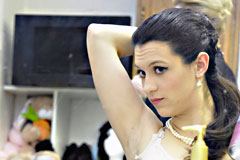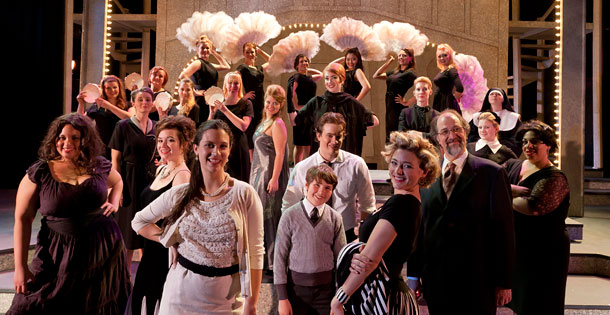
Creating our own masterpiece
Director’s note by Ernie Julia, associate professor of theatre
Anyone who has traveled to Italy can attest to the sensual feast that seems to hang in the air and fill your every breath. Passion radiates through the glorious art of Michelangelo and da Vinci, sumptuous food and wine titillate the palate, the warmth of the Tuscan sun soothes the body, and the breeze off the Mediterranean feels like a lover’s caress. In every city—from Rome, to Florence to Venice—it seems like love is the source that powers the streetlights. It is the land of sensuality, and for centuries Italy’s greatest artists have been driven mad by the urgent need to somehow capture its magical spirit and reflect it back through their art.
With inspiration like this, no wonder Italy has generated artists who are celebrated as great geniuses. Through their passion for life and thirst for answers, they seem to capture the essence of the human spirit. By the late fifties and early sixties, a young Federico Fellini was revered as one of these great Italian artists. With La Strada, Nights of Caberia, and La Dolce Vita, he was catapulted to international stardom as a visionary who used film as his medium to combine a sensual aesthetic with an intellectual lens. He made movies that were heralded as cinematic masterpieces. He was also at the center of the glamorous world of “cinema Italiano,” where sports cars and sunglasses, high fashion and amore captured the world’s imagination, as we all watched through the mysterious beauty of a black and white lens. The likes of Sophia Loren, Gina Lollobrigida, and Marcello Mastroianni became icons to a world on the brink of social and sexual revolution.
Living in the age of the paparazzi and the press, any creative artist struggles with the pressure of living up to his or her own reputation. Such struggles can sometimes lead to artist’s block, when the well of creativity goes dry and the soul seems to become barren. Attempting to juggle this with the complexities of one’s personal life—childhood, family, marriage, and of course sex—can lead to an overwhelming crisis.
After a brilliant streak of early films, Fellini’s well of creativity seemed to go dry. But rather than whither, he dug deeper, and out of crisis grew his semi-autobiographical film 8 1/2, which most critics consider his great masterpiece. A psychological dreamscape inspired by the writings of Carl Jung, it is a movie about a charismatic film director in crisis who has no ideas for his next film. His personal life is falling apart and his professional life is caving in. By going into his own subconscious and confronting his personal struggles Fellini created a film that examines the deepest aspects of the human condition.
This movie resonated for many in its examination of crisis, love, creativity, and the urgent need to understand it all. It inspired Maury Yeston and Arthur Kopit to use it as the basis for another dramatic art form—a Broadway musical. Nine was the unexpected hit of the 1982 season when it opened to rave reviews, winning the Tony Award for best musical. Yeston and Kopit take us into the mind of Guido Contini, a loveable antihero in crisis.
While on top of the world, Guido becomes a master at juggling everything life hands him. But the balls have begun to drop, and no matter how frantically he tries to keep them in the air, he cannot. A nine-year-old boy can find delight in the game of juggling; a man approaching mid life can turn it into a frantic act of desperation. On the brink of his 40th birthday, Guido begins the race against his own mortality, juggling for his life. Like most of us at some point in our lives, he wants to stay young forever; a state where everything is possible, imagination flourishes, and life’s wonders are there for the taking. This youthful energy contributes to his irresistible appeal. He wants it all, but he’s about to learn why that’s impossible. He loves three women and cannot see a way to exist without any of them. But when the human heart is at stake and adult relationships form, the naïve impulses of a child can lead to disaster, affecting all those who love him. Everyone but Guido seems to recognize he must grow up or self-destruct. As willing players in his life, the three women he loves must also examine their roles in this drama in order to grow and take control of their own destinies. The other powerful women in his life, including his mother, his producer, his critic, and his muses, provide unique points of view that help bring Guido to the moment of truth where he must choose or lose.
Sometimes we have to visit the child we once were to become the adult we are capable of being. If we do the tough work when crisis erupts, the well of creativity will very possibly fill again. And with that creativity, we each have the power to be an artistic genius, creating our own masterpiece from the life we are given.

